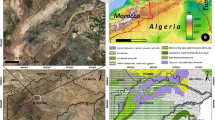Abstract
Realization of good returns in the mining venture needs careful planning, scheduling, design and optimization of all mining activities which are dependent upon reliable resource estimates. The mineral resource estimation method employed in a deposit thus plays a major role in reduction of risks associated in mining. In this study, indicator kriging, ordinary kriging and inverse distance weighting methods are compared for Monywa K and L deposits. Correlation coefficients in the regression analysis of downhole composites compared with the ordinary kriging estimates for K and L deposits were 0.982 and 0.985 respectively, thus selecting it as the best estimator for the two deposits.
Similar content being viewed by others
References
Emery, J., Estimation of Mineral Resources Using Grade Domains: Critical Analysis and a Suggested Methodology, J. S. Afr. Inst. Min. Metall., 2005, vol. 105, no. 4, pp. 247–255.
Glacken, I., Snowden, D., and Edwards, A., Mineral Resource Estimation, Mineral Resource and Ore Reserve Estimation—The Ausimm Guide to Good Practice, The Australasian Institute of Mining and Metallurgy, Melbourne, 2001, vol. 23, no. 1, pp. 189–198.
Morley, D., Financial Impact of Resource/Reserve Uncertainty, J. S. Afr. Inst. Min. Metall., 1999, vol. 99, no. 6, pp. 293–301.
Kiš, I.M., Comparison of Ordinary and Universal Kriging Interpolation Techniques on a Depth Variable (A Case of Linear Spatial Trend), Case Study of the Š and rovac Field, Rudarsko-Geološko-Naftni Zbornik, 2016, vol. 31, no. 2, pp. 41–58.
Wackernagel, H., Multivariate Geostatistics, Springer, 2003, pp. 79–88.
Ozturk, D. and Kilic, F., Geostatistical Approach for Spatial Interpolation of Meteorological Data, An. Acad. Bras. Ciênc., 2016, vol. 88, no. 4, pp. 2121–2136.
Al-Hassan, S. and Boamah, E., Comparison of Ordinary Kriging and Multiple Indicator Kriging Estimates of Asuadai Deposit at Adansi Gold Ghana Limited, Ghana Min. J., 2015, vol. 15, no. 2, pp. 42–49.
Sinclair, A.J. and Blackwel, I. G.H., Applied Mineral Inventory Estimation, Cambridge University Press, 2002.
Lin, Y.-P., Chang, T.-K., Shih, C.-W., and Tseng, C.-H., Factorial and Indicator Kriging Methods Using a Geographic Information System to Delineate Spatial Variation and Pollution Sources of Soil Heavy Metals, Environ. Geol., 2002, vol. 42, no. 8, pp. 900–909.
Rahimi, H., Asghari, O., Hajizadeh, F., and Meysami, F., Assessment the Number of Thresholds on Tonnage-Grade Curve in IK Estimation. Case Study: Qolqoleh Gold Deposit (NW of Iran), 4th Int. Mine & Mining Industries Congr. & Expo, 2016.
Mei, G., Xu, L., and Xu, N., Accelerating Adaptive Inverse Distance Weighting Interpolation Algorithm on a Graphics Processing Unit, R. Soc. Open Sci., 2017, vol. 4, no. 9, pp. 1–19.
Li, L., Losser, T., Yorke, C., and Piltner, R., Fast Inverse Distance Weighting-Based Spatiotemporal Interpolation: A Web-Based Application of Interpolating Daily Fine Particulate Matter PM2. 5 in the Contiguous US Using Parallel Programming and KD Tree, Int. J. Env. Res. Public Health, 2014, vol. 11, no. 9, pp. 9101–9141.
Bronshtein, I.N., Handbook of Mathematics, Springer, 2004.
Samal, A.R., Sengupta, R.R., and Fifarek, R.H., Modeling Spatial Anisotropy of Gold Concentration Data Using GIS-Based Interpolated Maps and Variogram Analysis: Implications for Structural Control of Mineralization, J. Earth Syst. Sci., 2011, vol. 120, no. 4, pp. 583–593.
Rossi, M.E. and Deutsch, C.V., Mineral Resource Estimation, Springer Netherlands, 2013.
Glacken, I. and Blackney, P., A Practitioners Implementation Of Indicator Kriging, Beyond Ordinary Kriging, 1998.
Silva, F. and Soares, A., Grade-Tonnage Curve: How Far Can It Be Relied Upon, Annual Conf. of the Int. Association for Math. Geology, Cancún, 2001, pp. 1–11.
Funding
The authors are grateful to the CRSRI Open Research Program, SN : CKWV2018471/KY, the National Nature Science Foundation of China, grants nos. 51804235 and 41672320, and the National Key R&D Plan, grant no. 2018YFC0808405 for their financial support.
Author information
Authors and Affiliations
Corresponding author
Additional information
Published in Fiziko-Tekhnicheskie Problemy Razrabotki Poleznykh Iskopaemykh, 2020, No. 1, pp. 92–103.
Rights and permissions
About this article
Cite this article
Mwangi, A.D., Jianhua, Z., Innocent, M.M. et al. Selection of a Resource Estimation Method for Monywa K and L Copper Deposits in Myanmar. J Min Sci 56, 84–95 (2020). https://doi.org/10.1134/S1062739120016515
Received:
Revised:
Accepted:
Published:
Issue Date:
DOI: https://doi.org/10.1134/S1062739120016515




